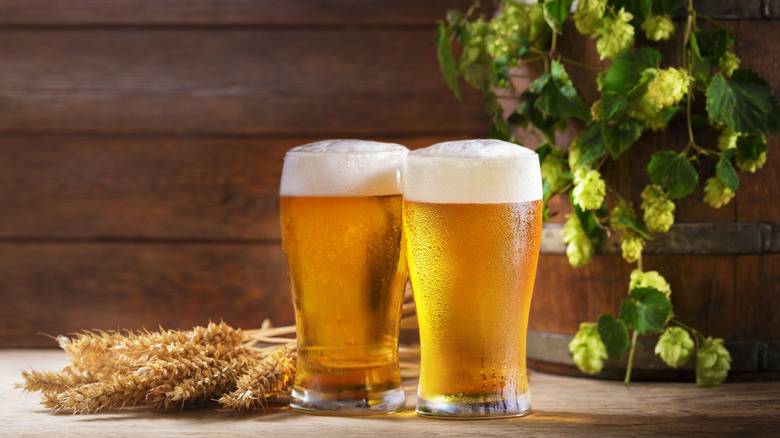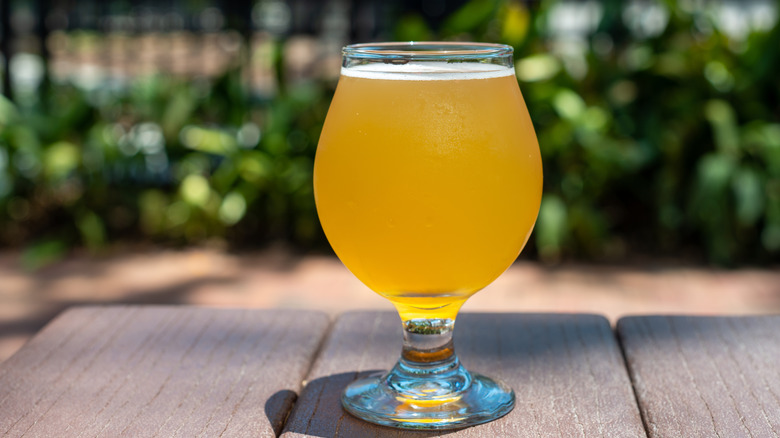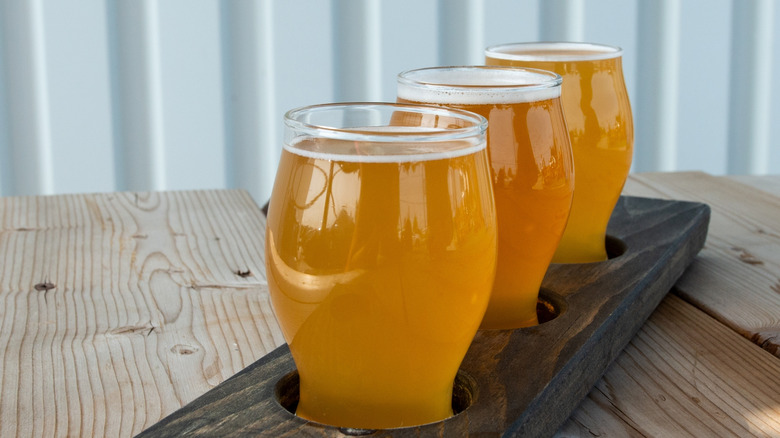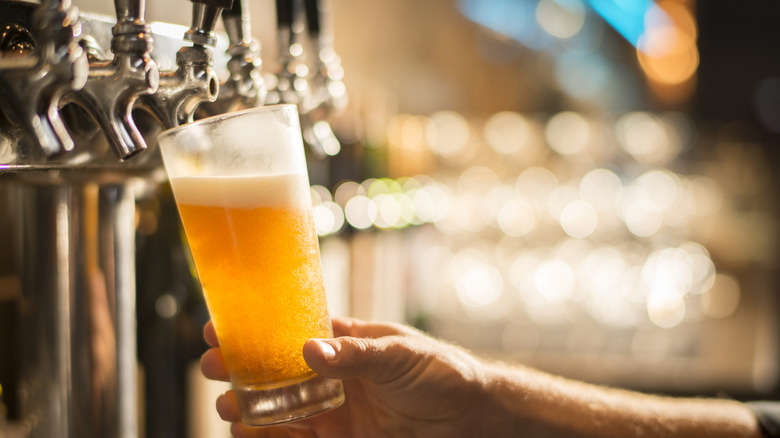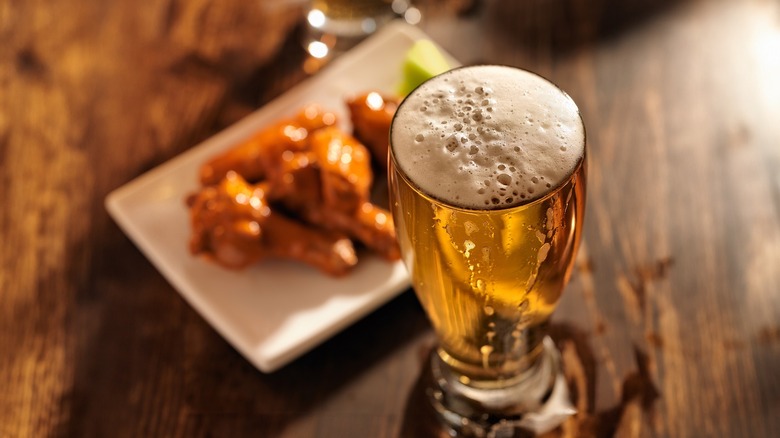IPA Vs Pale Ale: What's The Difference Between These Beers?
If you're new to the world of craft beer, browsing a brewery's menu can be a bit overwhelming. Between all the stouts, porters, and pilsners, it can be hard to know exactly what you want to order, but by focusing on just a couple of beers at a time you'll quickly be able to pick out a favorite. Two of the most popular craft beers are IPA and pale ale. While very different when it comes to taste and intensity, there are actually quite a few similarities between these beers. Both fall under the broad umbrella of pale ales, use similar ingredients, and share historical roots. In fact, the IPA (also known as India Pale Ale) evolved from the pale ale, and both rely on a combination of malt, hops, water, and yeast to create their distinct flavors.
Both pale ales and IPAs undergo a similar brewing process to most beers. Basically, barley is first mashed into malt and combined with water, where enzymes convert starches to sugars. The resulting product, called wort, is then separated via boiling before hops are added. What differentiates and IPA from a pale ale is the heavier addition of hops throughout the process, which amps up the bitterness and aroma. The higher hop content in IPAs gives them a more pungent flavor, while pale ales tend to have a more balanced profile between the malt and hops.
Pale ales are more balanced
Pale ales have a long and storied history, dating back to 18th-century England. The term "pale ale" originally referred to any light beer during a time when darker, more robust porters and stouts that were more popular. Pale ales gained popularity since they were seen as more refreshing and easier to drink than the heavier, darker beers. The classic English pale ale, often called a "bitter," became a staple of British pub culture and laid the foundation for modern variations.
When it comes to taste, pale ales are defined by their balance between the sweetness of malt and the bitterness of hops. Typically, pale ales are brewed with a moderate amount of hops that provide floral, citrus, or piney notes, but these flavors never overpower the malt. American pale ales (APA) have become particularly popular in the craft beer scene, known for their slightly stronger hop presence and flavors of citrus and pine. Within the pale ale category, there are also substyles like English bitters, Belgian pale ales, and American amber ales, each differs in flavor and intensity while maintaining a balanced flavor.
IPAs have more hops
IPAs, or India Pale Ales, evolved from traditional pale ales in the late 18th century, and was developed to survive long sea voyages from England to British colonies in India. Brewers added extra hops to act as a natural preservative, resulting in a more bitter beer with a higher alcohol content. If you're interested, check out our retelling of the origin of IPA beer. Over time, the intense hoppy character of IPAs became its defining trait, and the style took on a life of its own, especially as craft beer has become more and more popular in the United States.
Modern IPAs are all about hops. These beers can range from intensely bitter and resinous to more fruity and juicy, depending on the hops used. Walk into any craft brewery and you're likely to find dozens of styles of IPAs, including the American IPA, which is known for its intense, earthy taste, and the New England IPA (NEIPA) with a fruity, smokey flavor. Double IPAs (DIPA) and Imperial IPAs take things even further with higher alcohol and hop contents.
Differences in flavor and strength
In terms of flavor, pale ales are known for an even, palatable taste. You'll also often find pale ales that have notes of spice, caramel, citrus, or even flowers depending on the type of hops and malt used. In contrast, IPAs have a much more pronounced hop bitterness, with flavors that tend to lean more on the earthy side like pine or fruit. The higher hop content often leaves a lingering bitterness on the palate, making IPAs more assertive in flavor than their pale ale counterparts. IPAs are often served in a specific glass — learn more in our guide to beer glasses.
The alcohol content also tends to differ between these two styles. Pale ales generally have an alcohol by volume (ABV) in the range of 4% to 6%, making them a lighter option for casual drinking. IPAs, on the other hand, typically have a stronger ABV, ranging from 6% to 8%, with some Double IPAs or Imperial IPAs reaching up to 10% or more. This difference in strength can impact the mouthfeel and overall drinking experience, with IPAs often delivering a more robust, warming sensation compared to the lighter, crisper finish of pale ales.
Food pairings
The flavor differences between these two beers means that they pair well with a wide range of food. With their balanced flavor profile, pale ales pair well with everything from grilled meats and burgers to roasted vegetables. The malty sweetness complements rich, salty flavors, while the moderate hops provide just enough bitterness to cleanse the palate. Pale ales, like many beers, scientifically go well with spicy foods, as their refreshing profile can mellow out heat without overwhelming the dish.
IPAs, on the other hand, tend to shine with bolder, more intense flavors. The bitterness of an IPA can cut through rich, fatty dishes like fried chicken, pizza, or barbeque, while the fruitier hop varieties complement spicy foods such as curries or tacos.
At their core, both pale ales and IPAs are part of the same brewing tradition, with IPAs simply being a more hop-forward evolution of pale ale. While they share many similarities, their differences in flavor, strength, and food pairings give each beer its own unique identity. Pale ales offer a balanced, approachable drinking experience, ideal for casual settings and meals. IPAs, with their bold hop flavors and higher alcohol content, are perfect for those looking for something more intense and adventurous. Whether you're drawn to the balanced harmony of a pale ale or the bold, bitter punch of an IPA, there's a beer for every palate and occasion.
